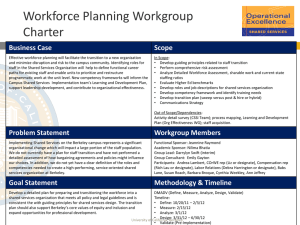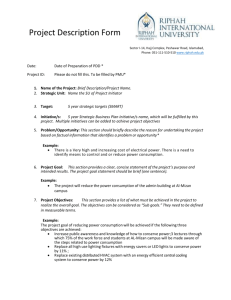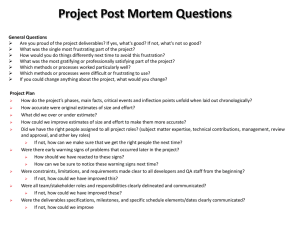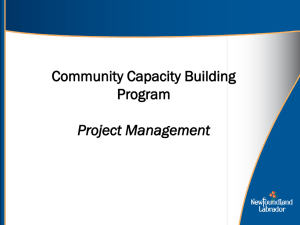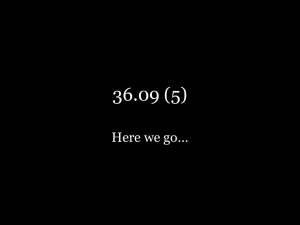Operational Excellence: Communications Snapshot
advertisement
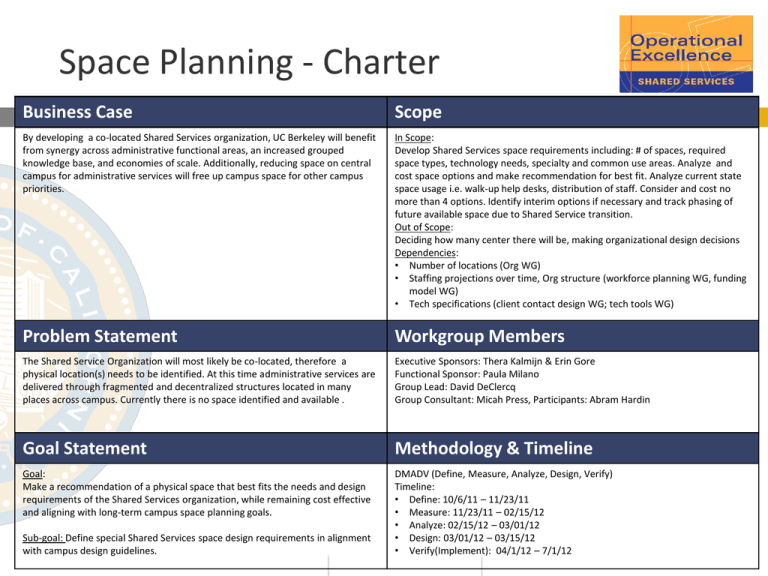
Space Planning - Charter Business Case Scope By developing a co-located Shared Services organization, UC Berkeley will benefit from synergy across administrative functional areas, an increased grouped knowledge base, and economies of scale. Additionally, reducing space on central campus for administrative services will free up campus space for other campus priorities. In Scope: Develop Shared Services space requirements including: # of spaces, required space types, technology needs, specialty and common use areas. Analyze and cost space options and make recommendation for best fit. Analyze current state space usage i.e. walk-up help desks, distribution of staff. Consider and cost no more than 4 options. Identify interim options if necessary and track phasing of future available space due to Shared Service transition. Out of Scope: Deciding how many center there will be, making organizational design decisions Dependencies: • Number of locations (Org WG) • Staffing projections over time, Org structure (workforce planning WG, funding model WG) • Tech specifications (client contact design WG; tech tools WG) Problem Statement Workgroup Members The Shared Service Organization will most likely be co-located, therefore a physical location(s) needs to be identified. At this time administrative services are delivered through fragmented and decentralized structures located in many places across campus. Currently there is no space identified and available . Executive Sponsors: Thera Kalmijn & Erin Gore Functional Sponsor: Paula Milano Group Lead: David DeClercq Group Consultant: Micah Press, Participants: Abram Hardin Goal Statement Methodology & Timeline Goal: Make a recommendation of a physical space that best fits the needs and design requirements of the Shared Services organization, while remaining cost effective and aligning with long-term campus space planning goals. DMADV (Define, Measure, Analyze, Design, Verify) Timeline: • Define: 10/6/11 – 11/23/11 • Measure: 11/23/11 – 02/15/12 • Analyze: 02/15/12 – 03/01/12 • Design: 03/01/12 – 03/15/12 • Verify(Implement): 04/1/12 – 7/1/12 Sub-goal: Define special Shared Services space design requirements in alignment with campus design guidelines. University of California, Berkeley Space Planning Workgroup: Deliverables (DMADV Project) Phase DEFINE MEASURE Deliverables Team Launch: Project Charter, Select Team Members, Workgroup Plan, High-level cost estimate, Working Assumptions, Preliminary space requirements, Preliminary space options Requirements: Identify critical business design requirements Develop Shared Services Design requirements that align with campus design guidelines Data Collection: Develop data collection plan Collect data of available spaces and costs Collect current space usage Data Analysis: Create Staffing Model with space projections Develop space usage benchmarking Develop space transition plan to track space becoming available Analyze Design Development: Develop Detailed Cost/Benefit Analysis Design Analysis: Analyze different facilities options to identify “best fit” option Recommend best fit option Develop preliminary Risk Assessment DESIGN Detailed Design: Complete detailed Risk Assessment Validated high level design (“Blueprint”) Pilot or early adopter plans University of California, Berkeley Project Snapshot DEFINE MEASURE ANALYZE What is the Goal? What are requirements? What are all designs? Steps: • Define the project (Charter) • Select and launch team • Develop workgroup project plan and schedule, RAPID • Preliminary risk review and plan • High-level cost estimate Deliverables: • Project Charter • Workgroup plan • Working assumptions • High-level cost estimate • Preliminary space requirements • Preliminary space options Steps: • Identify data needs and dependencies • Conduct detailed Voice of Business; Translate VOB in to Critical to Quality design requirements • Create space requirements model • Analyze current state space usage of inscope activities • Develop Space Transition Plan Deliverables: • Data Collection Plan • Prioritized “Critical to Quality (CTQs)” • Space requirements model • Space usage bench marking • Space Transition Plan Steps: • Generate, evaluate, and select model that best meets CTQs, design requirements, and budget constraints • Benchmark against existing cost and usage Deliverables: • Detailed Cost/Benefit Analysis • Prelim risk assessment • Select best space option • Tollgate Deck University of California, Berkeley DESIGN What is best design? Steps: • Detailed development of the selected design • Test design concepts and components • Tollgate Review Deliverables: • Validated high level design (“Blueprint”) • Detailed risk assessment • Pilot or early adopter plans • Design reviews and approvals • Tollgate Deck Verify Implementation (Conducted by Campus Shared Services Implementation Team) Steps: • Pre-implementation planning • Develop implementation plan • Implementation of early adopters • Full implementation Deliverables: • Pre-implementation plan • Implementation plan • Acquire and build out space
